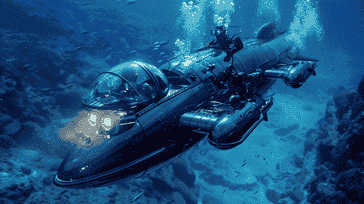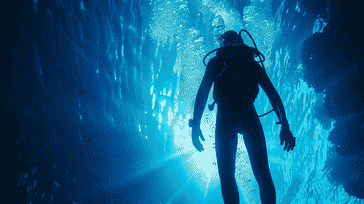
Welcome to the thrilling world of deep sea diving, where extreme sports and underwater exploration collide. In this article, we will take a closer look at the adrenaline-fueled world of deep sea diving and the fascinating physics that make it all possible. From the depths of the ocean to the wonders that lie beneath, we invite you to dive into the exciting realm of underwater adventure.
Deep sea diving is more than just an extreme sport; it's a fascinating blend of physics, exploration, and adventure. In this section, we'll delve into the science behind this exhilarating activity and discover the principles that make scuba diving possible.
At its core, scuba diving involves breathing underwater through a self-contained underwater breathing apparatus (or SCUBA). This equipment allows divers to explore the underwater world with ease and freedom. By inhaling air from a compressed air tank, divers can descend to incredible depths and stay submerged for extended periods.
The key to successful scuba diving lies in understanding the physics of pressure. As divers descend deeper into the water, the pressure increases exponentially. This means that every 33 feet (10 meters) of depth adds an additional atmosphere of pressure.
As the pressure increases, so does the risk of experiencing decompression sickness or "the bends." This is why divers must undergo specialized training and adhere to strict dive tables that dictate ascent rates and mandatory decompression stops.
In addition to managing pressure, scuba divers must also be mindful of buoyancy control. By adjusting their breathing rate and utilizing specially designed buoyancy control devices (BCDs), divers can achieve neutral buoyancy. This allows them to hover effortlessly in the water, conserving energy and exploring their surroundings more efficiently.
But it's not just the equipment that enables deep sea diving; it's also the techniques employed by divers. Underwater communication, navigation, and buddy systems are all essential components of a safe and enjoyable dive. These techniques ensure that divers can communicate effectively, navigate through unfamiliar environments, and provide assistance to one another when needed.
The true beauty of deep sea diving lies in the harmony between science, equipment, and technique. It's the perfect fusion of physics, exploration, and adventure, offering divers an unparalleled connection to the underwater world.
In the next section, we will explore the wonders that await underwater explorers. From vibrant coral reefs teeming with life to eerie shipwrecks frozen in time, the depths of the ocean hold endless possibilities for those who dare to venture below the surface.

Prepare to dive deep into the thrilling world of underwater exploration, where adventure sports enthusiasts embark on incredible journeys beneath the sea. With scuba diving as their means of transport, divers immerse themselves in a mesmerizing realm of hidden wonders and natural beauty.
Underwater exploration offers a multitude of awe-inspiring sights and experiences. One of the most captivating attractions is the vibrant and diverse marine life that thrives in coral reefs. These underwater ecosystems teem with an array of colorful fish, exotic sea creatures, and intricate coral formations. Divers have the opportunity to witness firsthand the delicate balance of nature, as they swim alongside these majestic creatures in their natural habitat.
"Underwater exploration takes us to a world that remains largely unexplored by humans. It's a journey of discovery, where every dive brings new surprises and unforgettable moments." - Laura Smith, professional diver
In addition to coral reefs, explorers are drawn to the mystery and allure of shipwrecks scattered along the ocean floor. These submerged relics of the past provide a glimpse into maritime history and serve as fascinating underwater playgrounds for divers. As they navigate through the wreckage, adventurers uncover tales of bygone eras, marvel at the rusted remnants, and perhaps stumble upon hidden treasures.
Underwater exploration encompasses various types of dives, each offering its own unique experience. From leisurely reef dives to thrilling drift dives or challenging cave dives, there is something to cater to every diver's preference and skill level. These expeditions allow divers to push their boundaries and forge a deep connection with the underwater world, creating memories that last a lifetime.
Diving: Journey to underwater depths
Underwater Exploration: Unveiling the secrets of the sea
Adventure Sports: Explore the thrill of the unknown
In summary, underwater exploration offers adventure sports enthusiasts the opportunity to dive into a world filled with unparalleled beauty, intrigue, and excitement. From encountering vibrant marine life in coral reefs to unraveling the mysteries of shipwrecks, divers embark on extraordinary journeys beneath the waves. With each dive, they uncover the wonders that beckon below, making underwater exploration a truly captivating adventure.
| Type of Dive | Features |
|---|---|
| Reef Dive | Discover vibrant coral reefs teeming with diverse marine life |
| Drift Dive | Experience the thrilling sensation of being carried along by ocean currents |
| Cave Dive | Explore mysterious underwater caves and caverns |
Experience the heart-pounding adventure of extreme deep sea diving. Plunge into the depths of the ocean and push the boundaries of human capability. It's a thrilling activity that combines adrenaline, exploration, and a deep connection with the underwater world.
To embark on this exhilarating adventure, divers need specialized gear and equipment designed to withstand the extreme conditions of the deep sea. From wetsuits and masks to oxygen tanks and diving fins, every piece of diving gear is essential for a safe and successful dive.
Deep sea diving presents unique challenges that test divers physically and mentally. As divers descend into the depths, they face increasing pressure, darkness, and limited visibility. Overcoming these obstacles requires skill, training, and a deep understanding of the underwater environment.
Yet, it is these challenges that make extreme deep sea diving so exhilarating. Divers must rely on their training and experience to navigate through the unknown, exploring underwater caves, shipwrecks, and vibrant coral reefs teeming with life. It's a profound and awe-inspiring experience that leaves divers with a sense of wonder and respect for the ocean's mysteries.
But deep sea diving isn't just about the thrill of the dive. It's also about the opportunity to contribute to scientific research and conservation efforts. Many divers participate in underwater surveys, documenting marine life and helping to protect fragile ecosystems. By combining adventure with environmental awareness, deep sea diving becomes a truly transformative experience.
Take a closer look at the essential gear used in extreme deep sea diving:
| Equipment | Description |
|---|---|
| Wetsuit | Designed to provide insulation and protect divers from the cold temperatures of the deep sea. |
| Diving Mask | Allows divers to see clearly underwater while protecting their eyes. |
| Oxygen Tank | Provides a supply of breathing gas to sustain divers during the dive. |
| Diving Fins | Aids in propulsion and maneuverability underwater. |
| Dive Computer | Monitors depth, dive time, and other crucial data to ensure divers' safety. |
| Dive Light | Provides illumination in the deep waters, revealing hidden wonders and enhancing visibility. |
With the right gear and a passion for adventure, deep sea diving offers an unparalleled thrill. It's a chance to explore the vastness of the ocean, witness breathtaking marine life, and experience the serenity that lies beneath the surface. So grab your gear, dive into the unknown, and discover the unforgettable world of extreme deep sea diving.

In conclusion, deep sea diving combines the thrill of extreme sports with the exhilaration of exploring the underwater world. Whether you're an experienced diver or a beginner, diving into the depths offers an adrenaline rush like no other.
By integrating the physics of diving with the beauty of underwater exploration, this extreme sport provides a unique and unforgettable experience. It allows divers to connect with nature on a whole new level, immersing themselves in the mysteries and wonders of the ocean.
From coral reefs teeming with colorful marine life to the haunting silence of sunken shipwrecks, the diversity of underwater landscapes is truly captivating. The rush of swimming alongside majestic creatures, such as dolphins or sea turtles, creates lasting memories that stay with divers for a lifetime.
So whether you're seeking an adrenaline rush or a deeper connection with nature, deep sea diving is the ultimate adventure. Dive into the depths, embrace the challenge, and let the ocean reveal its secrets.
Deep sea diving, also known as scuba diving, is a form of underwater exploration in which divers use scuba gear to breathe while diving into the depths of the ocean.
The depth to which deep sea divers can go depends on various factors, including their training, experience, and equipment. Some divers can reach depths of up to 130 feet, while others undergo specialized training to dive to greater depths.
Deep sea diving requires specialized gear, including a wetsuit or drysuit, diving mask, regulator, buoyancy control device (BCD), dive computer, and fins. Additional equipment may also be needed for diving in extreme conditions or at great depths.
Deep sea diving can be dangerous if proper safety precautions are not followed. However, with the right training, equipment, and adherence to safety protocols, the risks can be minimized, making it a relatively safe activity.
While anyone can learn to scuba dive, certain health conditions or physical limitations may restrict some individuals from participating in deep sea diving. It's essential to consult with a medical professional and undergo proper training to ensure your safety and suitability for diving.
The duration of a deep sea dive can vary depending on factors such as the diver's air consumption rate, depth of the dive, and decompression requirements. Most recreational dives range from 30 minutes to an hour, while technical dives may last several hours.
Deep sea diving comes with potential risks such as decompression sickness, nitrogen narcosis, and barotrauma. However, these risks can be mitigated by following proper dive procedures, undergoing training, and diving within your limits.
Yes, many people enjoy deep sea diving as a recreational activity. It offers the chance to explore underwater ecosystems, encounter marine life, and experience the unique tranquility of the ocean.
Yes, most scuba diving agencies require divers to obtain certification through training courses. These courses teach essential skills, safety procedures, and proper dive planning to ensure divers are prepared for the challenges they may face underwater.